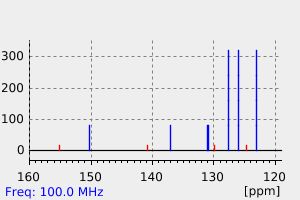(E)-2-(4-(trifluoromethyl)styryl)pyridine | 1027335-55-2
中文名称
——
中文别名
——
英文名称
(E)-2-(4-(trifluoromethyl)styryl)pyridine
英文别名
2-(4-(Trifluoromethyl)styryl)pyridine;2-[(E)-2-[4-(trifluoromethyl)phenyl]ethenyl]pyridine
CAS
1027335-55-2
化学式
C14H10F3N
mdl
——
分子量
249.235
InChiKey
FKPPLMCHUQMYSM-RMKNXTFCSA-N
BEILSTEIN
——
EINECS
——
-
物化性质
-
计算性质
-
ADMET
-
安全信息
-
SDS
-
制备方法与用途
-
上下游信息
-
文献信息
-
表征谱图
-
同类化合物
-
相关功能分类
-
相关结构分类
计算性质
-
辛醇/水分配系数(LogP):4
-
重原子数:18
-
可旋转键数:2
-
环数:2.0
-
sp3杂化的碳原子比例:0.07
-
拓扑面积:12.9
-
氢给体数:0
-
氢受体数:4
反应信息
-
作为反应物:描述:(E)-2-(4-(trifluoromethyl)styryl)pyridine 、 对氯三氟甲苯 在 [RuCl2(p-cymene){n-Bu2P(OH)}] 、 potassium carbonate 作用下, 以 甲苯 为溶剂, 反应 18.0h, 以77%的产率得到2-[2,2-bis{4-(trifluoromethyl)phenyl}vinyl]pyridine参考文献:名称:单组分次膦酸钌(II)催化剂可通过金属-配体协同活化C-H摘要:明确定义的次膦酸亚膦酸钌(II)配合物可在广泛的范围内实现芳烃和烯烃的化学,位点和非对映选择性CH功能化。低至0.75 mol%的催化剂载量反映了其出色的催化活性,并且据报道是迄今为止获得血管紧张素II受体拮抗剂重磅炸弹药物最省钱的途径。机理研究表明,通过单电子转移(SET)型基本过程可发生动力学相关的C-X裂解,并为PA辅助的C-H钌化步骤提供了证据。DOI:10.1002/chem.201504851
-
作为产物:描述:1-(2-bromovinyl)-4-(trifluoromethyl)benzene 在 potassium fluoride 、 bis(1,5-cyclooctadiene)nickel (0) 、 N,N-二甲基乙酰胺 、 4,4'-二叔丁基-2,2'-二吡啶 、 sodium hydroxide 、 magnesium chloride 、 锌 作用下, 以 异丙醇 为溶剂, 反应 16.5h, 生成 (E)-2-(4-(trifluoromethyl)styryl)pyridine参考文献:名称:镍卤化物与乙烯基溴的镍催化还原偶联制备乙烯基芳烃摘要:这项工作强调了在温和且易于操作的镍催化反应条件下,通过芳基卤化物与乙烯基溴的还原偶联来合成取代的乙烯基芳烃。广泛使用的芳基卤化物,包括杂芳族化合物和乙烯基溴化物,以中等至优异的收率生产了具有高官能团耐受性的产品。镍催化系统在两个C(sp 2)-卤化物偶合体之间显示出良好的化学选择性,从而证明了不同于其他逐步方案的机理途径。DOI:10.1002/anie.201607959
文献信息
-
Assisted Ruthenium-Catalyzed C−H Bond Activation: Carboxylic Acids as Cocatalysts for Generally Applicable Direct Arylations in Apolar Solvents作者:Lutz Ackermann、Rubén Vicente、Andreas AlthammerDOI:10.1021/ol800773x日期:2008.6.5Catalytic amounts of aromatic carboxylic acid MesCO H enabled efficient ruthenium-catalyzed direct arylations in apolar solvents with unparalleled broad scope via a concerted deprotonation-metalation mechanism.
-
Determination and application of the excited‐state substituent constants of pyridyl and substituted phenyl groups作者:Chao‐Tun Cao、Lu Yan、Chenzhong CaoDOI:10.1002/poc.4246日期:2021.9wavelengths of absorption maximum λmax were recorded. Also, the 234 λmax values of 1-substituted phenyl-2-arylethylene compounds (XAEY, where X is substituted phenyl) were collected. The excited-state substituent constants of three pyridyl groups and 23 substituted phenyl groups (total of 26) were obtained by means of curve-fitting method. Taking the λmax values of 358 samples of bi-arylethene derivatives合成了36个1-吡啶基-2-芳基乙烯XCH=CHARY(简称XAEY),其中X为2-吡啶基、3-吡啶基和4-吡啶基,Y为OMe、Me、H、Br、Cl、F, CF 3和CN。在无水乙醇中测量它们的紫外吸收光谱,并记录它们的最大吸收波长λ max。此外,还收集了 1-取代苯基-2-芳基亚乙基化合物(XAEY,其中 X 为取代苯基)的 234 λ最大值。采用曲线拟合法得到3个吡啶基和23个取代苯基(共26个)的激发态取代基常数。取 λ最大值以358个双芳基乙烯衍生物样品作为数据集,126个双芳基席夫碱样品(包括本工作合成的9种化合物)作为另一个数据集,以所得为参数进行定量相关分析,两个数据集都获得了良好的结果。验证了所得值的可靠性。本文研究结果可为含芳基共轭有机化合物光学性质的研究和应用提供激发态取代基常数。
-
A new insight into the push‐pull effect of substituents via the stilbene‐like model compounds作者:Chaotun Cao、Zhao Zeng、Chenzhong CaoDOI:10.1002/poc.4319日期:2022.42-diphenylpropylenes and substituted cinnamyl anilines as stilbene-like model compounds to investigate the factors dominating the push-pull effect of substituents via using the nuclear magnetic resonance chemical shift of bridging bond carbon atoms. It is demonstrated that the maximum push-pull effect is not always between the strong electron-donating D and strong electron-accepting A groups in D-π-A compounds. The action在本文中,作者报告了 1-吡啶基-2-芳基乙烯、1-呋喃基-2-芳基乙烯、1,2-二苯基丙烯和取代的肉桂基苯胺作为类二苯乙烯的模型化合物,以研究主导取代基推挽效应的因素通过使用桥键碳原子的核磁共振化学位移。证明了最大推挽效应并不总是在 D-π-A 化合物中的强给电子 D 和强电子接受 A 基团之间。D-π-A化合物中取代基推挽作用的作用方式主要由其分子母体结构决定。组的场/感应效应和共轭效应对推挽效应的贡献是不相等的。当 D-π-A 母体分子在一个平面上时,组的场/感应效应对推挽效应的影响大于或接近其共轭效应的影响。虽然母体分子是空间扭曲的,但推挽效应主要取决于基团的共轭效应。本文的结果可以为我们提供关于取代基推拉效应的新见解。
-
Ruthenium-Mediated C–H Functionalization of Pyridine: The Role of Vinylidene and Pyridylidene Ligands作者:David G. Johnson、Jason M. Lynam、Neetisha S. Mistry、John M. Slattery、Robert J. Thatcher、Adrian C. WhitwoodDOI:10.1021/ja3097256日期:2013.2.13and unproductive pathways. The formation of the desired products relies on C-H bond cleavage from this agostic complex in the presence of free pyridine to give the pyridyl complex [Ru(η(5)-C(5)H(5))(C(5)H(4)N)(═C═CHR)(PPh(3))]. Migration of the pyridyl ligand (or its pyridylidene tautomer) to the α-carbon of the vinylidene, followed by protonation, results in the formation of the 2-styrylpyridine. These一项联合实验和理论研究表明,[Ru(η(5)-C(5)H(5))(py)(2)(PPh(3))](+) 是一种关键的中间体,是一种活性催化剂因为,在温和条件下以 100% 原子效率的方式从吡啶和末端炔烃 HC≡CR (R = Ph, C(6)H(4)-4-CF(3)) 形成 2-取代的 E-苯乙烯基吡啶. 催化剂失活途径涉及形成含吡啶的配合物 [Ru(η(5)-C(5)H(5))(κ(3)-C(3)-C(5)H(4)NCH= CHR)(PPh(3))](+) 和随后的 1-ruthanaindolizine 复合物已被确定。使用 (13)C 和 D 标记以及 DFT 计算的机理研究表明,含亚乙烯基的中间体 [Ru(η(5)-C(5)H(5))(py)(=C=CHR)(PPh (3))](+) 形成,然后可以根据反应条件进行含有亚吡啶的失活产物或所需的产物。游离吡啶在该复合物中的 α-碳上的亲核攻击随后导致形成
-
Heck cross-coupling of vinyl heteroaromatic compounds with aryl and heteroaryl halides using Pd(II) complex under phosphine-free conditions作者:Manne Annapurna、P. Vishnuvardhan Reddy、Surya Prakash Singh、Mannepalli Lakshmi KantamDOI:10.1016/j.tet.2013.10.078日期:2013.12The palladium-catalyzed cross-coupling reaction of vinyl heteroaromatic compounds with aryl bromides and heteroaryl bromides is described using air and moisture stable N,N′,N″,O-tetrafunctional Pd catalyst under phosphine-free conditions. As a result a variety of trans-1,2-disubstituted vinyl heterocycles were obtained in high to good yields.
表征谱图
-
氢谱1HNMR
-
质谱MS
-
碳谱13CNMR
-
红外IR
-
拉曼Raman
-
峰位数据
-
峰位匹配
-
表征信息
同类化合物
(βS)-β-氨基-4-(4-羟基苯氧基)-3,5-二碘苯甲丙醇
(S,S)-邻甲苯基-DIPAMP
(S)-(-)-7'-〔4(S)-(苄基)恶唑-2-基]-7-二(3,5-二-叔丁基苯基)膦基-2,2',3,3'-四氢-1,1-螺二氢茚
(S)-盐酸沙丁胺醇
(S)-3-(叔丁基)-4-(2,6-二甲氧基苯基)-2,3-二氢苯并[d][1,3]氧磷杂环戊二烯
(S)-2,2'-双[双(3,5-三氟甲基苯基)膦基]-4,4',6,6'-四甲氧基联苯
(S)-1-[3,5-双(三氟甲基)苯基]-3-[1-(二甲基氨基)-3-甲基丁烷-2-基]硫脲
(R)富马酸托特罗定
(R)-(-)-盐酸尼古地平
(R)-(-)-4,12-双(二苯基膦基)[2.2]对环芳烷(1,5环辛二烯)铑(I)四氟硼酸盐
(R)-(+)-7-双(3,5-二叔丁基苯基)膦基7''-[((6-甲基吡啶-2-基甲基)氨基]-2,2'',3,3''-四氢-1,1''-螺双茚满
(R)-(+)-7-双(3,5-二叔丁基苯基)膦基7''-[(4-叔丁基吡啶-2-基甲基)氨基]-2,2'',3,3''-四氢-1,1''-螺双茚满
(R)-(+)-7-双(3,5-二叔丁基苯基)膦基7''-[(3-甲基吡啶-2-基甲基)氨基]-2,2'',3,3''-四氢-1,1''-螺双茚满
(R)-(+)-4,7-双(3,5-二-叔丁基苯基)膦基-7“-[(吡啶-2-基甲基)氨基]-2,2”,3,3'-四氢1,1'-螺二茚满
(R)-3-(叔丁基)-4-(2,6-二苯氧基苯基)-2,3-二氢苯并[d][1,3]氧杂磷杂环戊烯
(R)-2-[((二苯基膦基)甲基]吡咯烷
(R)-1-[3,5-双(三氟甲基)苯基]-3-[1-(二甲基氨基)-3-甲基丁烷-2-基]硫脲
(N-(4-甲氧基苯基)-N-甲基-3-(1-哌啶基)丙-2-烯酰胺)
(5-溴-2-羟基苯基)-4-氯苯甲酮
(5-溴-2-氯苯基)(4-羟基苯基)甲酮
(5-氧代-3-苯基-2,5-二氢-1,2,3,4-oxatriazol-3-鎓)
(4S,5R)-4-甲基-5-苯基-1,2,3-氧代噻唑烷-2,2-二氧化物-3-羧酸叔丁酯
(4S,4''S)-2,2''-亚环戊基双[4,5-二氢-4-(苯甲基)恶唑]
(4-溴苯基)-[2-氟-4-[6-[甲基(丙-2-烯基)氨基]己氧基]苯基]甲酮
(4-丁氧基苯甲基)三苯基溴化磷
(3aR,8aR)-(-)-4,4,8,8-四(3,5-二甲基苯基)四氢-2,2-二甲基-6-苯基-1,3-二氧戊环[4,5-e]二恶唑磷
(3aR,6aS)-5-氧代六氢环戊基[c]吡咯-2(1H)-羧酸酯
(2Z)-3-[[(4-氯苯基)氨基]-2-氰基丙烯酸乙酯
(2S,3S,5S)-5-(叔丁氧基甲酰氨基)-2-(N-5-噻唑基-甲氧羰基)氨基-1,6-二苯基-3-羟基己烷
(2S,2''S,3S,3''S)-3,3''-二叔丁基-4,4''-双(2,6-二甲氧基苯基)-2,2'',3,3''-四氢-2,2''-联苯并[d][1,3]氧杂磷杂戊环
(2S)-(-)-2-{[[[[3,5-双(氟代甲基)苯基]氨基]硫代甲基]氨基}-N-(二苯基甲基)-N,3,3-三甲基丁酰胺
(2S)-2-[[[[[((1S,2S)-2-氨基环己基]氨基]硫代甲基]氨基]-N-(二苯甲基)-N,3,3-三甲基丁酰胺
(2S)-2-[[[[[[((1R,2R)-2-氨基环己基]氨基]硫代甲基]氨基]-N-(二苯甲基)-N,3,3-三甲基丁酰胺
(2-硝基苯基)磷酸三酰胺
(2,6-二氯苯基)乙酰氯
(2,3-二甲氧基-5-甲基苯基)硼酸
(1S,2S,3S,5S)-5-叠氮基-3-(苯基甲氧基)-2-[(苯基甲氧基)甲基]环戊醇
(1S,2S,3R,5R)-2-(苄氧基)甲基-6-氧杂双环[3.1.0]己-3-醇
(1-(4-氟苯基)环丙基)甲胺盐酸盐
(1-(3-溴苯基)环丁基)甲胺盐酸盐
(1-(2-氯苯基)环丁基)甲胺盐酸盐
(1-(2-氟苯基)环丙基)甲胺盐酸盐
(1-(2,6-二氟苯基)环丙基)甲胺盐酸盐
(-)-去甲基西布曲明
龙蒿油
龙胆酸钠
龙胆酸叔丁酯
龙胆酸
龙胆紫-d6
龙胆紫







